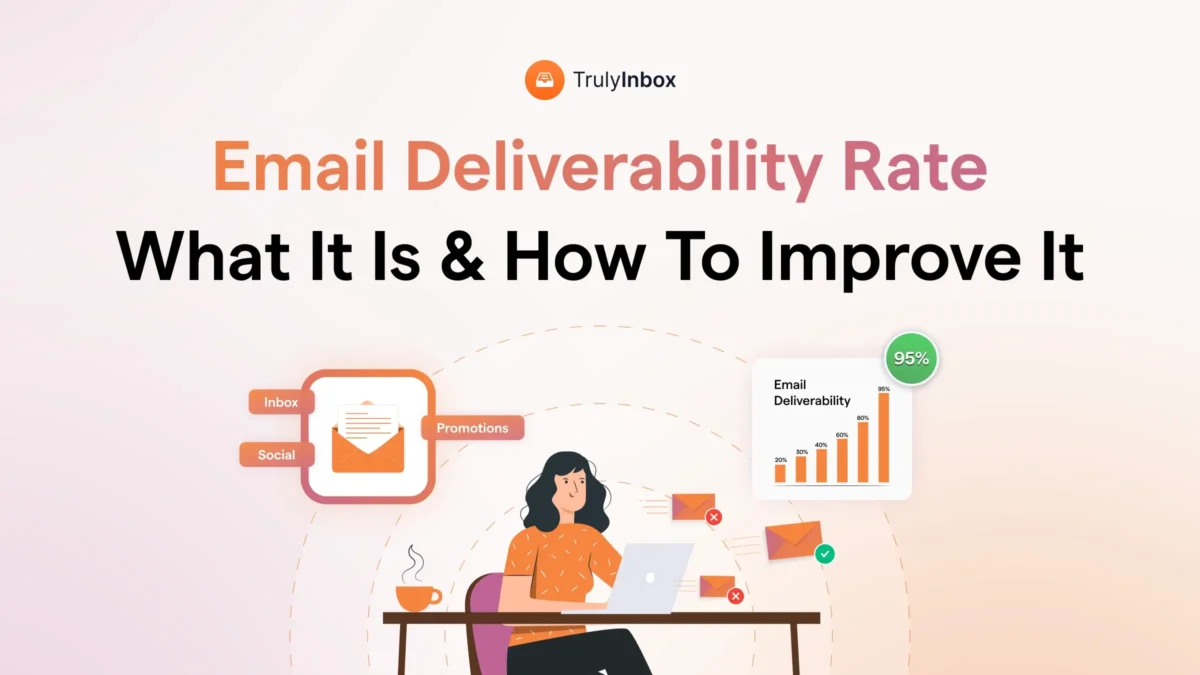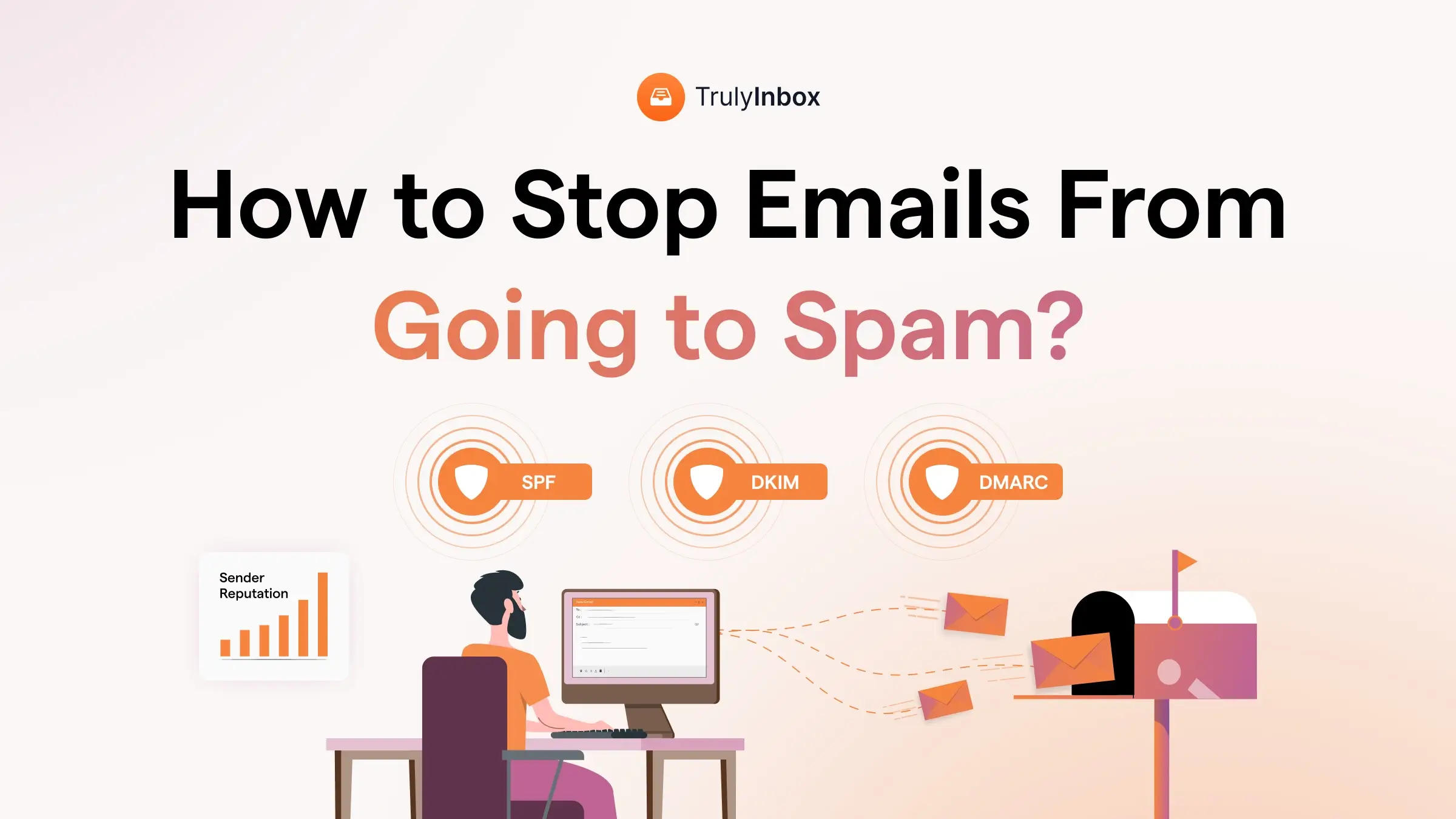Are your emails landing in the inbox or the spam folder?
It’s the first question you should ask when your open rates aren’t meeting expectations.
You have a targeted email list, the right subject line, and a personalized email copy.
But if your emails aren’t reaching the inbox, none of it matters.
This is where your email deliverability rate plays an important role. A critical metric that determines whether your emails are being seen.
Poor deliverability means your emails get filtered into spam, pushed to promotions, or blocked. And there’s no alert.
Your open rates drop, replies stop, and campaigns lose momentum.
In this guide, you’ll learn:
- What does the email deliverability rate mean
- Why it matters for cold emails, marketing, and transactional outreach
- The key factors that affect deliverability, like domain reputation, sender behavior, and technical setup
- Practical ways to monitor and improve it
If your emails aren’t getting delivered, all your efforts get wasted. Continue reading this blog post to fix your email deliverability rate.
Table of Contents
- What is the Email Deliverability Rate?
- What is a Good Email Deliverability Rate?
- How to Check Your Email Deliverability Rate
- How to Calculate the Email Deliverability Rate
- Factors That Influence Email Deliverability Rate
- How to Improve Your Email Deliverability Rate
- Boost Your Email Deliverability Rate
- Email Deliverability Rate FAQs
What is the Email Deliverability Rate?
Email deliverability rate means the percentage of emails that are successfully delivered to a recipient’s primary inbox.
Your emails shouldn’t land in Promotions, Spam, Socials, or Updates. They should reach the Primary Inbox, where your recipients are most likely to see them.
So, if you’ve sent 100 emails and 90 lands in the inbox, you’ve got an email deliverability rate of 90%!
Difference Between Email Delivery and Email Deliverability:
It’s easy to get confused between email delivery and email deliverability. Let me explain to you the actual difference:
Email delivery: It refers to the situation in which your recipient’s email server has accepted it. It’s the first step in the journey of your email to the recipient’s mailbox.
Email deliverability: It refers to how many of your emails made it to your recipients’ primary inboxes.
Why Does Email Deliverability Rate Matter?
When deliverability decreases, it creates a chain reaction that affects every part of your email campaign.
A poor email deliverability rate means:
- Emails land in spam or get blocked instead of reaching the inbox
- Open rates, replies, and conversions start to drop
- Your sender’s reputation takes a hit
- Campaign performance becomes unreliable and less effective
- Future emails are more likely to be filtered or delayed
What is a Good Email Deliverability Rate?
I’ll break down the key benchmarks in the table below by industry, company size, and email type.
- 95%+ is excellent – Inbox providers trust you as a legitimate email sender who uses valid emails and sends relevant emails to users.
- 89-95% is good – You’re doing well, but your bounce and spam rate could be holding you back. Just a few tweaks, and your deliverability will improve.
- 80-89% is acceptable – Most of your emails are still getting delivered to the inbox, but inconsistently. You might need to clean your email list, check your authentication records, and follow a consistent sending pattern.
- Below 80% is poor – You’re in red flag territory, which means you should immediately conduct an email deliverability audit to find and fix some fundamental issues with your email infrastructure.
This will give you a clear idea of what a good email deliverability rate looks like across different business scenarios.
How to Check Your Email Deliverability Rate?
To check your email deliverability rate, you can use a combination of your ESP’s native reports, free tools, and email marketing platforms.
- Use Your ESP’s Built-In Deliverability Reports
- Track and Interpret Deliverability Metrics
- Monitor Blacklist Status
- Set Up Ongoing Deliverability Monitoring Tools
- Test Manually Using a Seed Email List
- Run Inbox Placement Tests Using Third-Party Tools
Let me quickly show you how you can do this:
1. Use Built-In Deliverability Reports of Your ESP
As a first step, use your ESP’s email deliverability reports to determine your current standing.
You can use Google or Outlook’s native Postmaster Tools to check basic metrics like:
- Delivery rates: The percentage of emails that didn’t bounce back; this is often what the ESP displays.
- Bounce rates: Both hard bounces from invalid addresses and soft bounces from temporary issues. Google’s recommended bounce rate is <0.1%.
- Unsubscribe and complaint rates:High rates here often mean you’re targeting the wrong audience or your content falls short.
2. Track and Interpret Deliverability Metrics
To ensure your email deliverability stays on track, you must track these metrics regularly.
- Inbox placement rate: It refers to the percentage of emails that actually landed in the recipient’s inbox rather than promotions or social tab.
- Spam rate: It refers to the percentage of mail that lands in the spam folder, which is mostly ignored by users.
- Missing rate: It refers to emails that don’t reach the inboxes, usually blocked by ESP servers due to a bad sender reputation.
3. Monitor Blacklist Status
As soon as your email is listed on even one blacklist, your email deliverability can take a huge hit. Worse, you might not even know it’s happening until your campaigns start failing completely!
Check these blacklist monitoring tools regularly:
- MXToolbox for comprehensive blacklist checking
- Spamhaus for major spam database monitoring
- SURBL for URL-based blacklist checking
4. Set Up Ongoing Deliverability Monitoring Tools
When you’re sending thousands of cold emails, manually checking your deliverability might be very difficult.
That’s where monitoring tools can help you: they catch and flag issues like domain reputation drops, blacklisting, or even authentication errors!
Plus, these tools can alert you before problems start affecting your entire campaign. They save you valuable time, eliminate guesswork, and help you maintain a healthy sender reputation.
Pro Tip: Use a tool like Inbox Radar to find out how different ESPs are viewing and routing your emails.
5. Test Manually Using a Seed Email List
One good way to understand your email deliverability is to conduct manual spam tests. Here’s how it works:
- Select a list of seed emails.
- Create a spam-free template.
- Send emails to the seed addresses using that template.
You can see exactly which folder they land in and how they appear to recipients.
Set up test accounts on these major providers:
- Gmail (personal and Workspace accounts)
- Outlook (Outlook.com + Office 365)
- Yahoo Mail
6. Run Inbox Placement Tests Using Third-Party Tools
This is where you start tracking deliverability seriously. Testing tools send your emails to test inboxes and show exactly where they land. It’s the most reliable way to check how well you’re reaching the inbox.
Consider these testing platforms:
- Inbox Radar by Saleshandy is an all-in-one platform that helps you test inbox placement and track email deliverability metrics.
- GlockApps is a free tool that helps you verify your authentication, check inbox placement, and flag spammy content in emails.
- MxToolbox is a good option if you want a full report on your email authentication and MX records report.
Pro Tip: Test across all major providers. Gmail’s filters work differently from Outlook’s. What passes Gmail’s standards might fail elsewhere.
How to Calculate the Email Deliverability Rate
To calculate your email deliverability rate, you require more than just looking at your ESP’s delivery statistics. Let me show you what to do:
The Basic Email Deliverability Rate Formula
Email Deliverability Rate = (Emails Delivered to Inbox / Total Emails Sent) × 100
You can see a difference here from the delivery rate formula, which only counts emails that didn’t bounce.
Example of How to Calculate Email Deliverability Rate
Let’s say you send out 1,000 emails.
- 50 emails bounced: the recipient’s server didn’t accept them.
- That means 950 emails were delivered.
- Out of those, 760 landed in the inbox.
- And 190 ended up in the spam or any other folder.
Now let’s look at the numbers:
Delivery rate:
(950/1,000) × 100 = 95%
This simply means that your recipient’s servers did not reject the emails; instead, they were accepted.
Next, let’s calculate the deliverability rate:
(760/1,000) × 100 = 76%
This tells you how many actually reached the inbox!
So, while your email service provider (ESP) might show a 95% delivery rate.
Whereas, in actual reality, only 76% of your emails land in the inbox.
Next, let’s find out what factors actually influence these numbers.
Factors That Influence Email Deliverability Rate
Here is the list of factors that influence the email deliverability rate.
- Missing Essential Email Authentication Records (SPF, DKIM, DMARC)
- Violating Global Email Compliance Laws
- Failure to Follow Google and Yahoo 2025 Email Sender Rules
- Using Low-Quality or Unverified Contact Email Lists
- Writing Spam-Triggering Email Content or Subject Lines
- Irregular or Inconsistent Email Sending Behavior
- Poor Email Sender or Domain Reputation
- High Email Spam Complaints
- Damaged Email Sending Domain or IP Reputation
1. Missing Essential Email Authentication Records (SPF, DKIM, DMARC)
This is one of the most basic steps for email security. Email authentication is your way to prove you’re legitimate. Without proper SPF, DKIM, and DMARC records, email providers don’t trust you.
- SPF tells servers which IPs can send emails from your domain.
- DKIM adds a digital signature to verify authenticity.
- DMARC ties them together and tells servers what to do with suspicious emails.
If you miss this step, you will definitely send an email with a “maybe spam” label attached to it.
2. Violating Global Email Compliance Laws
Whether you’re running a marketing campaign or a cold outreach sequence, compliance is non-negotiable if you want to maintain good email deliverability and avoid penalties.
Let me explain the regional regulations that you must follow.
- CAN-SPAM Act for the USA: You must offer an opt-out link and sender information in your email.
- GDPR for Europe: You must have clear consent before emailing individuals (use double-opt-in for this).
- CASL for Canada: Requires express or implied consent to send commercial emails.
- PECR for the UK: Applies to both consent and privacy in electronic communications.
3. Failure to Follow Google and Yahoo 2025 Email Sender Rules
In 2024, Google and Yahoo introduced new rules for bulk email senders. These requirements remain critical in 2025.
Here’s what you need to know:
- Applies to bulk senders: These rules affect senders who send 5,000 or more emails per day to Gmail or Yahoo addresses.
- Purpose: The update aims to reduce spam and phishing and improve user trust in inboxes.
- Email authentication: You must implement SPF, DKIM, and DMARC for your domain.
- Spam threshold: Keep your spam complaint rate below 0.3% to stay in compliance.
- One-click unsubscribe: Include a one-click unsubscribe link using the proper List-Unsubscribe headers in your email headers.
- Microsoft consideration: While Microsoft hasn’t published identical rules, similar best practices apply to avoid Outlook/Hotmail inboxing issues.
Failing to meet these standards can lead to email rejections, spam folder placement, or complete domain-level blocks.
4. Using Low-Quality or Unverified Contact Email Lists
Sending emails to invalid addresses can lead to hard bounces.
When emails keep bouncing, providers take it as a sign you’re not keeping your list. That’s never good news for your campaigns.
I’d suggest using an accurate email list from trusted B2B data sources like Saleshandy Lead Finder, Apollo.io, or UpLead.
These platforms will give you accurate email addresses of prospects who match your ICP. So you can send emails without worrying about your bounce rate.
5. Writing Spam-Triggering Email Content or Subject Lines
Modern spam filters are smart: they don’t just check whether you’re using spammy content like “FREE” or “URGENT.”
Rather, they analyze your entire message, including:
- Subject line
- Email body
- Tone and context
- Links
- Attachments
They even go so far as to measure your engagement metrics, like the number of replies you’re getting.
If your email content sounds salesy or lacks context, there is a high chance of your emails landing in spam. Subsequently, it might even happen if your authentication records aren’t properly set.
6. Irregular or Inconsistent Email Sending Behavior
If you send 100 emails one day and 10,000 on the next, you’re inviting trouble. ESPs take such huge variations seriously and raise red flags.
Email providers pay attention to patterns. Consistency actually builds trust with their systems.
7. Poor Email Sender or Domain Reputation
Your reputation follows you across all your campaigns. It’s built on your previous sending behavior, complaint rates, and the level of engagement with your emails.
Prevention is everything that matters here; either you will hurt your reputation, which can take months to rebuild.
8. High Email Spam Complaints
If your recipients frequently mark your email as spam or unsubscribe, there is a high chance that it sends a negative signal to the ESP.
Even a 0.1% spam complaint rate can seriously damage your deliverability.
9. Damaged Email Sending Domain or IP Reputation
Both your domain and your IP address have their own reputations. Someone else’s bad sending behavior can affect your reputation and deliverability if they’re using the same IP address as you.
A dedicated IP gives you much more control, but it’s not a set-it-and-forget-it deal. You’ll need to keep sending regularly to build and maintain a good reputation.
We’ve covered what might be going wrong, so now let me show you how you can fix it and get your emails in the places they deserve to be.
How to Improve Your Email Deliverability Rate
Here is the list of the best practices you can use to improve and maintain your email deliverability rate.
- Set up SPF, DKIM, and DMARC records using tools like MXToolbox. If you’re unsure, take the help of your IT team to configure them.
- Use a subdomain like mail.yourcompany.com for outreach to protect your core domain’s reputation. It even helps you to improve inbox placement.
- Start with low sending volumes and gradually increase the number. You can use tools like TrulyInbox or MailReach to automate the warm-up process.
- Use tools like Saleshandy, ZeroBounce, or NeverBounce to remove invalid emails and protect your email deliverability.
- Don’t use all caps, spammy words, or fake offers. These can put your emails in the spam folder.
- Check your email content with GlockApps before sending. It helps catch spam issues early.
- Add the person’s name, company, or other details to make your email feel personal.
- Send emails at a steady rate. Sending too many at once can trigger spam filters.
- Track opens, clicks, and replies with your email tool. It shows what’s working and what needs fixing.
- Always add a clear unsubscribe link. This keeps your list clean and avoids spam complaints.
- Follow rules like GDPR and CAN-SPAM. Add your business address and remove anyone who opts out.
Boost Your Email Deliverability Rate
If you’ve made it this far, I’m sure you’re serious about measuring and improving your email deliverability rate.
I’ve covered everything, from what it means to how you can improve your deliverability. Read and follow these tips to make sure you maintain a high email deliverability rate.
If you’re unsure where to start or how to fix your domain reputation, get started with TrulyInbox. It helps automate the entire process from start to finish.
Give TrulyInbox a try and see the results.
Email Deliverability Rate FAQs
1. What is a good email deliverability score?
A good email deliverability rate is 90% or higher. A rate of 95% or higher is usually considered excellent.
2. Do different email providers have different deliverability rates?
In my experience, yes. Different email providers have different restrictive parameters. Gmail tends to be more restrictive than the other email providers.
3. How does list size affect email deliverability rate?
The list size does not directly impact the email deliverability rate. It can gradually have more inactive or invalid email addresses, which can affect the quality and eventually reduce the email deliverability rate.
4. How often should I check my email deliverability rate?
In my opinion, you should monitor deliverability weekly for active campaigns and monthly for the overall health of your campaigns. Any significant changes in your sending patterns require immediate monitoring.



